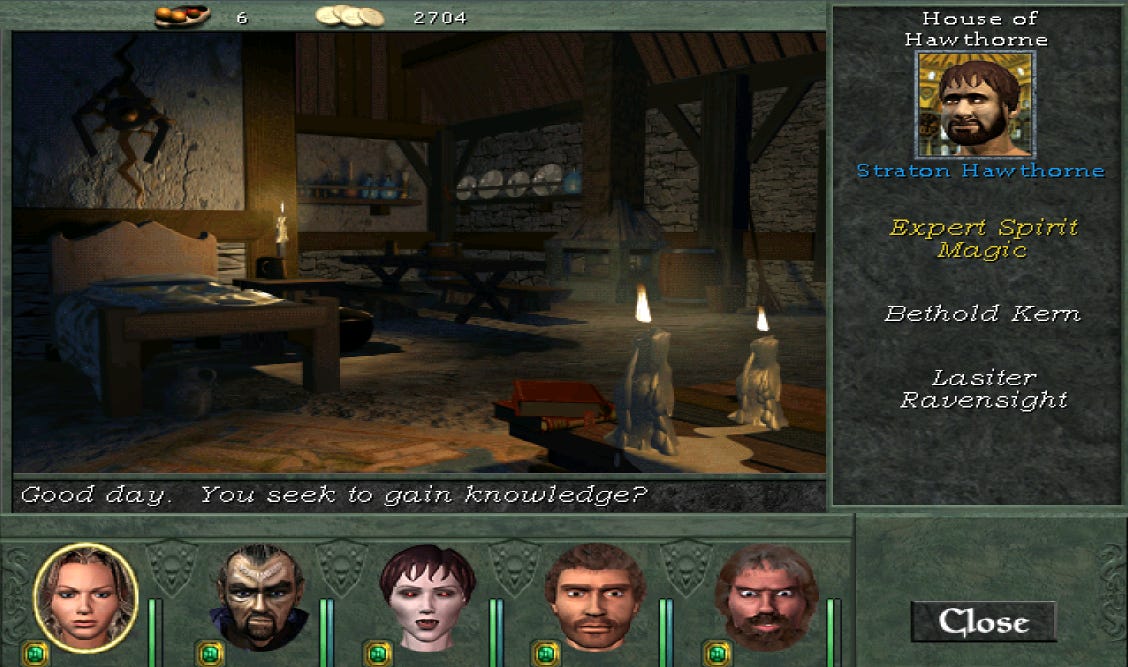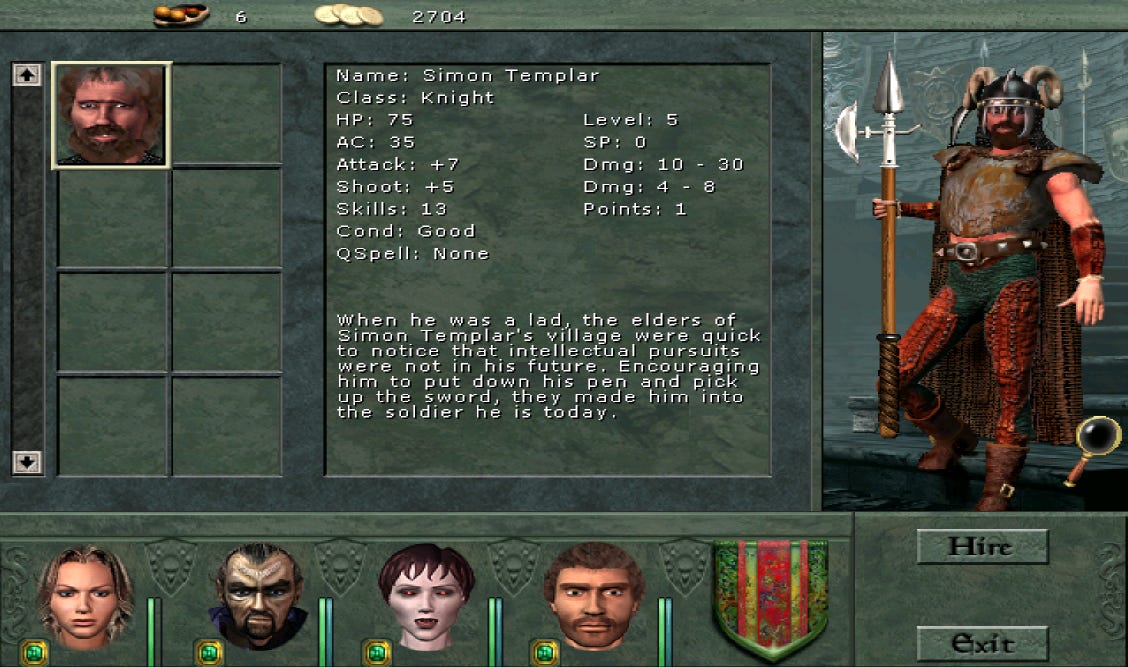Gaming: Might and Magic (7 + 8)
So, today, on a whim, I decided to re-install some games from my childhood that I haven’t been able to play properly for awhile, but now, thanks to the efforts of the modding community I am now able to run these old classics on a modern + linux system, and since I now also feel like reviewing things whenever I have the inspiration to write, here is a review of Might and Magic 7: For Blood and Honor and Might and Magic 8: Day of the Destroyer, combined because they are very similar games under the good, and while M&M 6 could also be included, I haven’t yet played through that one. 7 was my introduction to the series, then I followed with 8, and am still in the process of going back to the earlier entries.
Released: 1999, 2000
Developer: 3DO
Platform: PC
Story
The stories here are fairly simple, and mostly exist to push you along to explore the world, much like an Elder Scrolls story. In the same vein, these games are highly non-liniar, with most of the time being spent exploring, dungeon crawling, and questing, and then in between all that, squeezing in the whole saving the world thing.
In M&M 7, you have a story of warring factions, and a team of adventurers who recently became lords of the land of Harmondale after winning the castle in a contest, which leads in to a surreal twist in the storytelling, a branching path, and links to other games in the series.
8’s story is a little more traditional, with the adventurer starting out as a caravan guard, but being tangled up in a battle of epic scale with otherwordly entities, and exploring the world to gain support for the battles ahead, fending off the forces of the titular Destroyer.
Graphics
So, these games are relics, clearly. They may not look the prettiest, unless you really like the retro 3D world aesthetic (which I do!). The world is simplistic 3D polygons with minimal lighting effects outside of spells and simulating the day/night cycle. NPC’s and enemies are represented as sprites, and when you enter houses and shops, the screen switches to a prerendered backdrop, and there’s a surprising amount of detail and variance to these, with different houses, shops, special buildings, and confirmation screens for entering dungeons, all having different graphics, which also vary per region.
Technically speaking, the graphics are limited. The sprites are detailed enough to be clear about what they are representing, the world is barren but not ugly. The lighting is basic, but never an impediment. It’s not the most beautiful world, but it's not ugly either. It works.

Gameplay
In both games, you have your main interface as you explore, which shows you a map, your partys status, and the world around you. The UI is cluttered with clickable elements which give access to a variety of functions, and points of interest which show information when they are hovered over.
In M&M 7, you create a team of adventurers, choose their classes and starting abilities, names, portraits and voices, and this will be your team for the entire adventure. If you’re familiar with the original Final Fantasy, same idea.
In M&M 8, instead you create one character, and the remainder of your party is filled with a rotating cast of recruited characters, who you will gain through the story, and through optional side quests.
In both cases, for the character you create, you choose starting skills for them, and their class. But throughout the adventure, there will be plenty of additional skills to learn that have a wide variety of passive effects, all of which can be leveled up and upgraded, with the upper limit of the proficiency being defined by the users class. And later in the journey, there will be chances to upgrade the characters class, which gives access to new skills and raises the limits on proficiencies.

Every NPC in the world can be spoken to, though they are more useful in M&M 7. In 7, NPC’s can be recruited, with most characters being eligible, and having a unique function or passive buffs which can have a wide variety of effects, like giving access to high-level spells once per day, or increasing your resistance to effects, for a small cost of gold. M&M 8 abandoned this feature, and NPC dialog is a lot less interesting.
Mechanically speaking, both games play very similarly. You navigate the world in first-person, and interact with the world using the mouse, usually by clicking on things. Want to open a chest? Click on it. Talk to someone? Click. Cast magic? Open the spellbook, click a spell, click the target. It’s pretty easy to figure out.
You have an option between real-time and turn-based action for combat. In real-time, it’s a frantic affair of clicking on enemies, or pressing the attack keyboard shortcut, which spends your characters turn, making them go in to wait mode temporarily. In turn-based mode, it plays a lot like a traditional JRPG. Based on the characters speed, their actions come up in order, and you can take actions as you normally would in real-time. Each character takes an action, then you have a move phase, where you can re-position your party, 5 steps in any direction. Then, the enemies take their actions, they’ll move in on you, and make their attacks. Your actions during battle are the same as they are during any time in the adventure, you can strike things with either melee or ranged weapons, cast a spell on allies, enemies, or an area, or use items, such as potions to heal or buff characters, and scrolls which allow any character to cast the spell written on it even if they don’t know the spell or can’t learn it.
Combat mechanics under-the-hood are standard Dungeons and Dragons rules. It’s dice rolls. Weapon damage is calculated in notation like `2d6`, meaning 2 6-sided dice rolls, added to related skill level and modifiers.
As you talk to NPC’s, you gain quests. Completing these quests give you experience, items, and other interesting rewards. In M&M8, these quests may also reward you with new party members.
Audio
The music is simple but pleasant, with simple background themes playing through each area that, while they may not be the most memorable tracks, do bring a nice ambience.
Voice acting is fairly minimal, but functional. Mostly it is relegated to barks and shouts, like characters announcing when they’re afflicted with status effects, or the grunts of damage and death, or quite amusing screams when falling from heights. There is no voicing for conversations, any dialog between the players and NPC’s is purely textural.
Extras
These games are classic open-world adventures, it’s mostly exploring, completing quests, killing dragons, goblins, and the like, spelunking through dungeons, and eventually taking on the big bad. But in each game, there is at least one quite interesting distraction. From the very start of M&M8, and after an early questline in M&M7, when visiting any tavern you can play a game of Arcomage, which is a 1v1 (against the CPU) card game. In each turn, you play cards, which expend resources. Resources are gained at the start of each turn based on your structures. Cards can influence each players resources and structures, and heal and damage each players wall and tower. The objective is to either; build your tower up to the predetermined limit specified by the tarvern you’re playing in, or; destroy the enemies tower. These minigames are pretty simple, but they are a good time, and serve a purpose! Completing at least one game in each tarvern nets you a nice amount of gold, and in one of the games, is related to a quest to win every tarvern. It’s a welcome addition, and I definitely have spent quite a lot of time just playing Arcomage.
A side note of something I only just recently discovered, is the Tomb of Brinne in M&M8. I discovered this as a youth and assumed it was just developer rooms, as the building is full of idle NPC’s that do nothing, but have very internet forum names, which stand out a bit in the world of Samara the Blacksmith’s, to now interacting with a GameGurl777. But, it’s not so much a developer room, but a memorial room to a user of old New World Computing forums, who was very active in the CRPG communities, and so when he passed away, he was memorialised in a few games across the genre, from M&M8, to Ultima, and even in Deus Ex. It took me awhile to find this story, because the last time I saw this room I was a kid with dialup internet, so “looking things up” like this wasn’t really a common thing, but I was playing through it today and decided to just look it up now. So, still learning new things to this day!
Final Thoughts
It may just be my nostalgia speaking, since I played these as a kid, being some of my first PC games I ever owned, but I love these two. They’re simple, but they’re nice, and in the ranks of old CRPG’s like Wizardry and Daggerfall, the Might and Magic series deserves to be up there with them.








